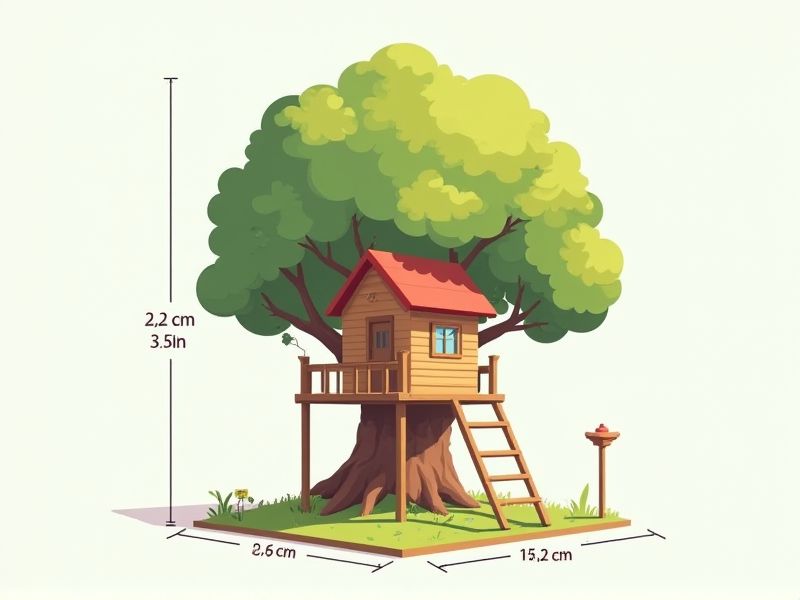
When planning a treehouse, understanding standard dimensions helps ensure safety and usability. A typical children's treehouse usually measures around 6 to 8 feet wide and 8 to 10 feet long, providing enough space for play without overwhelming the supporting tree. The platform is often built 6 to 10 feet above ground, but it's important to stay closer to the lower end for younger children. Always adjust dimensions based on the size and strength of the tree, and consult local building codes or guidelines to ensure your treehouse is both fun and safe.
Tree Trunk Diameter
Treehouse standards typically consider tree trunk diameter as a critical factor for safety and stability, with a recommended minimum diameter of 12 inches at a height of 4.5 feet. This measurement ensures the tree can adequately support the weight of the structure and occupants. It's essential to assess not just the diameter but also the tree species, as some trees, such as oaks and maples, provide stronger support than others. When planning your treehouse, prioritize selecting a healthy tree with a well-established root system, as it will significantly enhance the longevity and safety of your build.
Platform Height
The standard treehouse platform height typically ranges from 6 to 10 feet above the ground, providing an ideal balance of safety and adventure. This height allows for an unobstructed view of the surrounding environment while minimizing the risk of injury from falls. Many builders recommend incorporating sturdy railings and secure ladders to ensure safe access to the platform. When designing your treehouse, consider the specific tree species and its strength to determine the best height for stability and longevity.
Platform Area
The Platform area of the Treehouse is designed to maximize vertical space while ensuring safety and comfort, featuring a minimum height of 6 feet and a width of 4 feet. Constructed from treated timber, the platform's load capacity can support up to 1,000 pounds, accommodating multiple users or additional accessories. The surface is equipped with a non-slip finish, enhancing safety for children and adults alike. You can customize this area with features such as built-in seating or mini gardens, adding both functionality and aesthetic appeal to your outdoor space.
Support Beam Length
The standard support beam length for a treehouse typically ranges from 8 to 12 feet, depending on the design and tree structure. Each beam should be crafted from durable materials, such as treated lumber or engineered wood, ensuring a weight capacity of at least 1,500 pounds. Properly installed support beams must be anchored securely to the tree and provide adequate spacing of 4 to 6 feet apart to maintain stability. When calculating your treehouse support, consider the weight distribution and local weather conditions, as wind and rain can significantly impact structural integrity.
Railing Height
The standard railing height for treehouses typically ranges from 36 to 42 inches, ensuring safety while still providing a clear view. This height complies with safety regulations and helps prevent accidental falls, making it suitable for both children and adults. When constructing your treehouse, consider using sturdy materials such as pressure-treated wood or metal for optimal strength and durability. Regular maintenance, including inspections for wear and damage, is essential to maintain the integrity of the railing throughout the years.
Load Capacity
The standard load capacity for treehouses typically ranges from 200 to 400 pounds per square foot, ensuring they can safely support multiple occupants and additional weight from furniture or decorations. Structural integrity is paramount, with high-quality materials like pressure-treated lumber or marine-grade plywood recommended for construction. It's crucial to account for dynamic loads, which may include children playing or wind forces, when designing your treehouse. Regular inspections and adherence to local building codes further enhance safety and durability, making your treehouse a secure haven for enjoyment.
Access Ladder Length
The Access ladder length for treehouses should be a minimum of 8 to 10 feet to ensure safe and comfortable entry. Ideally, the ladder should have a width of 16 to 18 inches for stability, accommodating both adults and children. Constructing a ladder with a 75-degree angle will promote ease of use while minimizing risks of falling. For maximum safety, consider adding handrails and ensuring the ladder is securely anchored to the treehouse structure.
Roof Pitch
The standard roof pitch for a treehouse typically ranges between 3:12 and 6:12, ensuring adequate drainage while providing structural stability. A 4:12 pitch is often favored, as it balances aesthetics and functionality, allowing for sufficient headroom and protection against the elements. Your treehouse design should also account for local weather conditions, with steeper pitches being more effective in snowy regions. Consider using durable materials such as metal or shingles, which can withstand varying environmental demands while complementing the overall design.
Window Size
Treehouses should ideally feature windows sized between 24 and 36 inches wide to optimize natural light and ventilation. A well-placed window can improve your treehouse's overall aesthetics while ensuring a connection with nature. Choosing double-hung or casement windows can enhance energy efficiency, offering better insulation and control over airflow. Installing a window with UV protection can also safeguard the interior furnishings from sun damage, extending their lifespan.
Door Dimensions
Treehouse door dimensions typically range from 28 to 36 inches in width and 80 inches in height, accommodating standard sizes for ease of access and functionality. A well-designed door should allow for a minimum clearance of 1 inch from the floor to prevent tripping hazards and ensure smooth opening. When considering thermal efficiency, a solid core door with a thickness of at least 1.75 inches can significantly enhance insulation and durability. You can optimize the entrance experience by incorporating a lightweight yet sturdy material, ensuring both safety and aesthetic appeal in your treehouse design.
